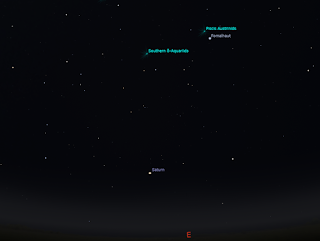 |
 |
| Evening sky looking east from Adelaide at 11 pm local time in South Australia on the 29th. The starburst marks the radiant (the point where the meteors appear to originate from) of the Southern Delta Aquariids. Similar views will be seen elsewhere at the equivalent local time (click to embiggen). |
Evening sky looking North from Adelaide at 2:30 am local time on July 30th in South Australia. The starburst marks the radiant (the point where the meteors appear to originate from) of the Southern Delta Aquariids. Similar views will be seen elsewhere at the equivalent local time (click to embiggen). |
The Southern Delta-Aquariids meteor shower runs from from 12 July to 23rd August, peaking on Saturday night/ Sunday morning
July the 29th-30th this year. The number of meteors you will see depends on how high the radiant
is above the horizon, and how dark your sky is. This shower is fairly
faint, with the highest rate of around a meteor every 4 minutes (more detail below).
The ZHR
for Southern Delta Aquariids is 25 meteors per hour. The figure ZHR is zenithal hourly rate. This is the number of meteors
that a single observer would see per hour if the shower’s “point of
origin”, or radiant, were at the zenith and the sky were dark enough
for 6.5-magnitude
stars to be visible to the naked eye.
In practice, you will never see
this many meteors as the radiant will be some distance below the zenith.
Also, unless you are out deep in the countryside, the darkness will be
less than ideal. As well, moonlight will significantly reduce rates. This year the waxing crescent Moon sets before radiant rise, so won’t interfere. How
many are you likely to see in reality? I discuss this further down,
lets talk about when to see them first.
At 11 pm, face east, and look around 4 hand spans above the horizon. The brightest object above above the horizon is Saturn. The
radiant is another 6 spans above Saturn. This meteor
shower should be visible from 10.00 pm
until dawn. The best rates will be at 2:30 am on the evenings/mornings of the 29/30th and 30th/31st.
At 2:30 am people in the suburbs should see a meteor around once every 10 minutes,
and in the country about once every 4 minutes at 2:30 am in the mornings of the 29th and 30th.
When looking, be sure to let your eyes adjust for at least
5 minutes so your eyes can be properly adapted to the dark. Don’t look
directly at the radiant site, because the meteors will often start
their “burn” some distance from it, but around a hand-span up or to the
side. Be patient, although you should see an average of
a meteor every six to four minutes, a whole stretch of time can go by
without a meteor, then a whole bunch turn up one after the other.
Make
yourself comfortable, choose an observing site that has little to
obstruct the eastern horizon, have a comfortable chair to sit in (a
banana lounger is best), or blankets and pillows. Rug up against the cold. A hot Thermos of
something to drink and plenty of
mosquito protection will complete your observing preparations. As well
as meteors, keep an eye out for satellites (see Heavens Above for predictions from your site).
The sky will also be particularly beautiful, with the Milky Way
stretching over the sky and constellation of Scorpius in the west and Saturn gracing
the eastern-northern sky.

an estimate of what the shower will be like from your location (you
may need to enter your longitude and latitude, surprisingly, while
Adelaide and Brisbane are hard-wired in, Sydney and Melbourne are not).
Unfortunately, both Chrome and Firefox have changed their security
settings to prevent plugins from running, and the flux estimator only
runs under Internet Explorer or the Internet Explorer tab under Edge, now.
You
need to choose 5 Southern Delta Aquariids and remember to set the
date to 29-30 July or 30-31 July 2025′


